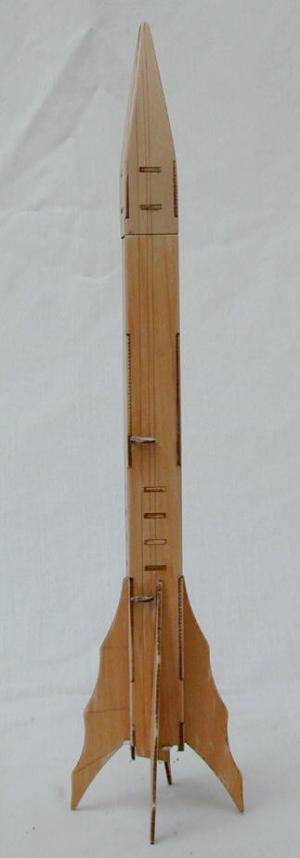| Construction Rating: | starstarstarstar_borderstar_border |
| Flight Rating: | starstar_borderstar_borderstar_borderstar_border |
| Overall Rating: | starstarstar_borderstar_borderstar_border |
Photo Courtesty of Frank
Ross 
Brief:
An Angular, wooden Airframe, with parachute recovery.
Construction:
The kit arrived in the standard plastic bag and all parts were in good shape.
The instructions were easy to follow, but it is imperative that you read them
thoroughly, a couple of times. The parts were laser cut from a plywood. It is
not especially clear how some pieces are formed or attached so do a lot of dry
fitting. The fit of the wood changed when the white glue was added. This caused
the wood to swell. So I had to scrape the wood, dry fit, and glue again. Taking
your time is a must. The nose cone was the most difficult part. Bending the
wood to shape and holding it there was a trick. I used CA and a few rubber
bands.
Finishing:
There was really no finishing needed, I just used a clear coat, and let the
natural wood show through.
Construction Rating: 3 out of 5
Flight:
The kit was baffled and I just use 1 sheet of wadding and an Estes B6-6 for the
first flight. There is a Teflon motor holder. The rocket was prepared like most
standard kits. The flight was straight and fast with a little spin due to the
fin slants.
Recovery:
The shock cord was a rubber tied to an eyelet at the top of the inner bracing /
baffle & an eyelet at the nose cone. I felt it may be short, but I built
this stock. At apogee there was no 'chute. I lost sight of it coming down, but
a crack recovery crew found it. The 'chute never deployed. I looked as if the
ejection charge blew past the motor, due to the square shape.
Flight Rating: 1 out of 5
Summary:
This was a very challenging kit to build. The damage was too much to repair. If
I were to build this again, I would find a way to keep the gases forward to
pressurize the recovery device.
Overall Rating: 2 out of 5
Sponsored Ads
 |
 |











